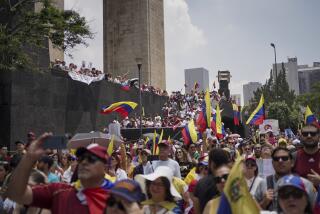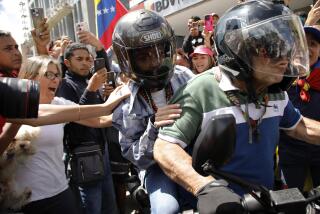15-Party Opposition Bloc Stages Anti-Sandinista March
- Share via
MASAYA, Nicaragua — About 5,000 people stirred by fireworks, brass bands and anti-government insults marched through this city Sunday in a show of unity among the major parties preparing to challenge Sandinista rule in the Nicaraguan elections next February.
Although it has not accepted the government’s election rules, a 15-party opposition bloc staged the march as an informal campaign kickoff while it tries to negotiate better terms for entering the race.
“Now is the time for the consciousness of the people to awaken,” shouted Miriam Arguello, a Conservative Party leader, as the marchers reached their destination outside a Gothic-style Roman Catholic Church. “Those who stayed home today out of fear or laziness should know: if you do not start fighting for democracy now, it will soon be too late.”
90-Minute March
Speeches before and after the 90-minute march offered a preview of the opposition’s campaign themes. Orators portrayed the decade-old Sandinista revolution as a one-party dictatorship exhausted by an unpopular war of its own making against the Contras, excessive military spending, corruption and a failure to halt the nation’s slide into poverty.
“Our people are hungry; they don’t have work; they are sick, but they have passion for liberty,” said Virgilio Godoy of the Independent Liberal Party, who is often mentioned as a possible presidential candidate. “Now even the hospitals are sick, because this is a country that suffers the virus of a corrupt and terrorist Sandinismo. “
Party activists ran along the march route painting the slogan “Death to the Nine Dictators” on walls, a reference to the nine Sandinista comandantes .
Masaya, 20 miles southeast of Managua, is the cradle of the urban insurrection that helped the Sandinistas oust strongman Anastasio Somoza in July, 1979. The marchers went unchallenged by pro-Sandinista mobs, which harassed some opposition candidates in 1984, or by the police.
Among the demonstrators were dozens of the 1,500 teachers on strike in scattered Nicaraguan cities in defiance of the government and leaders of their pro-Sandinista union. Most teachers earn about $15 per month, and the government, while rejecting demands for higher pay, has urged other workers to donate money to them.
Speaking after the march, strike leader Hortensia Rivas declared: “We don’t want handouts. We don’t want to bleed the working class. We have made a concrete proposal: reduce the military budget that consumes 60% of the people’s money.” Politicians who addressed the crowd backed the teachers’ demands.
More than anything else, the speakers stressed the need for the broadest possible electoral front against the Sandinistas. The 15-party bloc ranges from Communist to Conservative.
Complicating matters, the main opposition currents--Conservatives, Liberals and Social Christians--are themselves split into several parties. But in recent weeks, the Liberals and the Social Christians have reached accords to stick together. And after much wrangling, the 15-party bloc named five leaders to negotiate with the Sandinistas on its electoral demands, which include suspension of military conscription and opposition control of a television station during the campaign.
More to Read
Sign up for Essential California
The most important California stories and recommendations in your inbox every morning.
You may occasionally receive promotional content from the Los Angeles Times.













